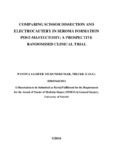| dc.contributor.author | Pandya, Sameer M | |
| dc.date.accessioned | 2017-01-05T06:27:31Z | |
| dc.date.available | 2017-01-05T06:27:31Z | |
| dc.date.issued | 2016 | |
| dc.identifier.uri | http://hdl.handle.net/11295/98988 | |
| dc.description.abstract | Background: Seroma following mastectomy is a common occurrence thus drains are left in situ for at least two weeks. The type of Instrument used during dissection to raise skin flaps has been widely studied and electrocautery has been shown to significantly increase seroma formation compared to other instruments.
Objective: To determine the difference in seroma formation after mastectomy between scissor dissection and electrocautery.
Materials and Methods: This was a single-blinded, prospective randomized controlled study with a sample size of 80 patients. This study was carried out over a period of 6 months. The participants were randomly divided into two groups of 40 each. One group underwent scissor dissection and ties for haemorrhage only while the other was subjected to electrocautery during skin flap fashioning. Data such as operating time and estimated blood loss, seroma presence, total volume of drainage, duration of drainage and drain retention, complications such as infection, wound dehiscence and flap necrosis were noted.
This data was collected on a pre-designed data sheet and entered into a computer and analysed using Statistical Package for Social Sciences (SPSS) for windows version 21.
Results Incidence of seroma formation was 51.3% for electrocautery against 38.7% for scissor which was statistically significant up to 7 days (P=0.0179). The average number of days seroma was drained was 10.65 days in the electrocautery group while 4.92 days in the scissor group and this was found to be significant with a P <0.0001.
The total volume drained on average was 121.2 mls for the scissor group as compared to 233.4 mls in the electrocautery group. Highest volume drained was 585mls in the study group with 760 mls in the control group. There was a significant difference in these outcomes with P<0.0001.
When comparing the complications, 4 (10%) developed Infection, 1 (2.5%) had dehiscence and 1 (2.5%) developed flap necrosis the scissor group and 11 (27.5%), 5 (2.5%) and 1 (2.5%) respectively in the electrocautery group. There was significant difference in the two groups for infection and dehiscence.
Conclusion Scissor dissection reduces seroma formation in terms of duration and volume and reduced complications post operatively making it a viable option during mastectomies in our setup. | en_US |
| dc.language.iso | en | en_US |
| dc.publisher | University of Nairobi | en_US |
| dc.rights | Attribution-NonCommercial-NoDerivs 3.0 United States | * |
| dc.rights.uri | http://creativecommons.org/licenses/by-nc-nd/3.0/us/ | * |
| dc.title | Comparing scissor dissection and electrocautery in seroma formation post-mastectomy; a prospective randomised clinical trial | en_US |
| dc.type | Thesis | en_US |
| dc.description.department | a
Department of Psychiatry, University of Nairobi, ; bDepartment of Mental Health, School of Medicine,
Moi University, Eldoret, Kenya | |


